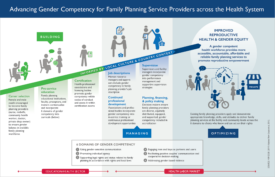In many low- and middle-income countries, health systems face shortages of qualified health workers, and decision-makers lack the data and tools needed to optimize existing resources.

Applying Gender Competency to the HRH2030 Health Worker Life Cycle .
Infographic | July 21, 2020

A gender-competent health worker strives create equitable opportunities for women, men, girls, and boys to make voluntary and informed decisions based on their needs.
In global health, gender competency enables health workers to identify how different norms, social constructs, roles, expectations, power differentials, opportunities, and constraints assigned to women, men, girls, and boys may influence behavior and choices. Gender competency should be incorporated and learned in pre-service education settings but takes practice and experience to master and sustain. To show the many ways gender competency can apply for the health workforce, this version of the HRH2030 Health Worker Life Cycle visually illustrates the dynamics of the health labor market and the complex range of potential interventions to incorporate gender competency in strong HRH systems.
